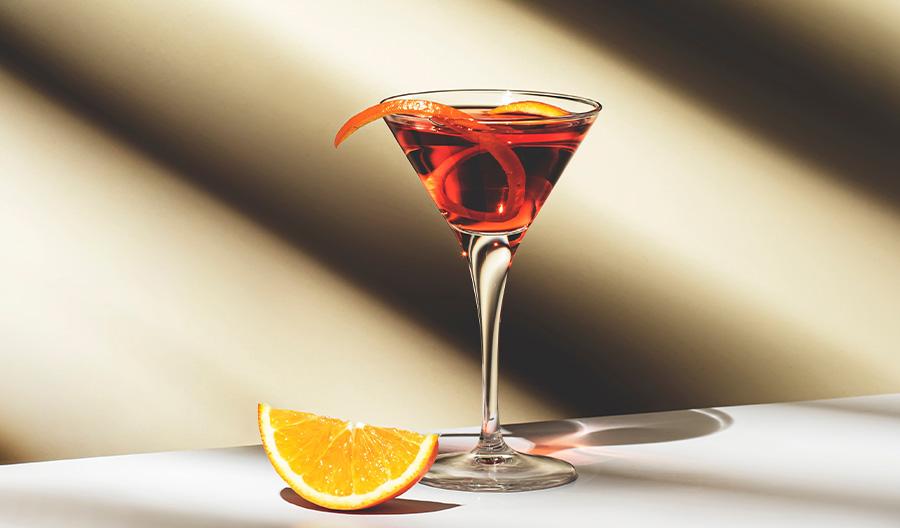Vermouth is a key ingredient in a number of classic cocktails, like a martini, Negroni or Manhattan. But for decades, vermouth took a backseat to the other elements of these drinks like gin, bourbon and whiskey. But vermouth is having a moment, and understanding the different vermouth styles is key to shaking (or mixing) up a delicious cocktail.
Here’s a look at the different vermouth styles and how they can be incorporated into many different cocktails.
What Is Vermouth?
Vermouth has been around for centuries and was originally created for medicinal purposes. It’s a fortified wine, which means distilled alcohol (like brandy or a neutral spirit) is added to increase the alcohol content and stop the fermentation process.
The fortified wine must then be infused with botanicals to be considered vermouth. Some common infusions include wormwood, orange peel, juniper, star anise and angelica root. Many brands keep their exact ingredients top secret, though. This is why the flavor profile of the final product varies depending on the region and producer.
Generally, vermouth comes in sweet or dry varieties. According to the European Union, the product must contain 75% wine to be considered vermouth. Vermouth’s alcohol by volume (abv) ranges from 16%–18%, slightly higher than unfortified wine’s 9%–14% abv. It’s still considered lower-proof than most spirits.

Sweet Vermouth
Sweet vermouth traditionally comes from Italy, and usually contains 130 grams or more of sugar per liter. This vermouth style can be red or white. They vary slightly in flavor, but both red and white vermouth can be used interchangeably in cocktails calling for sweet vermouth.
Sweet red vermouth could be described as the flavor of warming spices, such as clove, cinnamon [or] nutmeg. Think of fall and wintertime spice. Sweet white vermouth will have the flavor profiles of vanilla, citrus and spiciness.
Sweet red vermouth, also known as rosso, is classically used in a Negroni or Manhattan. Other cocktail options include a vermouth spritz, an Americano cocktail or simply drinking this fortified wine on its own.
Using sweet red vermouth in sangria adds a beautiful texture and complexity. The herbal and bitter foot flavors play nicely with red wine and fresh fruits.
Adding aromatic, earthy and spiced bitter components [to vermouth] will round up the cocktail and add complexity to it.
Dry Vermouth
Dry vermouth originated in France and was traditionally made with wormwood, a key ingredient in absinthe. It’s light in color and more herbaceous, floral and citrusy, compared to sweet vermouth, Bonath explains. It typically contains less than 50 grams of sugar per liter.
Dry vermouth also contains oxidated flavors, so when its mix it with gin, for example, it adds a saline twist which stimulates the tongue and causes it to salivate.
The classic use for dry vermouth is a martini. A favorite is a 50/50 Martini with equal parts gin and dry vermouth, garnished with both an olive and lemon zest. The drink can be described as “light-bodied, nutty [and] mineral,” adding that the dry vermouth softens and freshens up the gin’s botanical and juniper notes.
This type of vermouth also pairs well with dark spirits. We often forget that whiskey can have delicate floral notes that dry vermouth can shine a spotlight on.
Extra-Dry Vermouth
Extra-dry vermouth is even less sweet than dry varieties, with less than 30 grams of sugar per liter. It has lemon, orange and herbaceous notes. It tends to go well with sharp, acidic flavors.
If you’re looking to add botanicals to a drink without increasing the sugar content, then extra-dry vermouth is a great way to go. It’s also commonly used in a martini.
Amber Vermouth
Amber vermouth is an in-between of red vermouth and dry vermouth. Depending on how you look at it, it’s semi-dry or semi-sweet and tends to be fruity and floral.
If you want a martini on the sweeter side, amber is a step up from dry vermouth. If you want your Manhattan on the drier side, amber vermouth does it.

